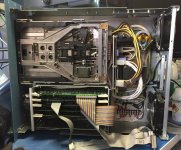NF6X
Veteran Member
I'm getting close to bringing up my S-100 chassis for the first time, populated with a set of Compupro cards. My full card set consists of:
I think that I would like to start with a ROM-resident monitor for initial debugging, before I try booting up from any floppy disks. So, I figure I should install a ROM-resident monitor in a 2732 EPROM on the CPU-Z for initial bring-up, with banks disabled as needed on the RAM 17 to avoid conflicts. Later, I can disable the ROM bank and switch in RAM instead. Yes, I'm aware of the mods needed on the CPU-Z to use 2732 instead of 2716, as well as the apparent error(s) in the manual on that topic.
I'm a bit confused about which Z-80 monitors might be suitable, particularly without needing any patches. It looks like MASTER.Z80 can be used on the CPU-Z, but when I look at the equates in the code, it's not clear to me whether the pre-compiled hex file is compatible with using the System Support 1 for the serial console without any patches. The code seems to be making references to some sort of "propeller" at 0x00/0x01 for console I/O.
Can anybody suggest a suitable pre-assembled ROM-resident monitor that I should be able to use as-is on my CPU-Z card for my initial bring-up? I'd prefer to put off needing to modify and re-assemble anything until I have the whole system up and running under CP/M.
- CPU-Z
- System Support 1
- RAM 17
- Disk 1
- Interfacer 4
I think that I would like to start with a ROM-resident monitor for initial debugging, before I try booting up from any floppy disks. So, I figure I should install a ROM-resident monitor in a 2732 EPROM on the CPU-Z for initial bring-up, with banks disabled as needed on the RAM 17 to avoid conflicts. Later, I can disable the ROM bank and switch in RAM instead. Yes, I'm aware of the mods needed on the CPU-Z to use 2732 instead of 2716, as well as the apparent error(s) in the manual on that topic.
I'm a bit confused about which Z-80 monitors might be suitable, particularly without needing any patches. It looks like MASTER.Z80 can be used on the CPU-Z, but when I look at the equates in the code, it's not clear to me whether the pre-compiled hex file is compatible with using the System Support 1 for the serial console without any patches. The code seems to be making references to some sort of "propeller" at 0x00/0x01 for console I/O.
Can anybody suggest a suitable pre-assembled ROM-resident monitor that I should be able to use as-is on my CPU-Z card for my initial bring-up? I'd prefer to put off needing to modify and re-assemble anything until I have the whole system up and running under CP/M.

